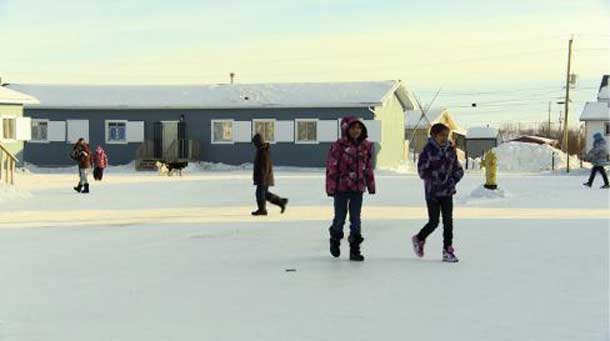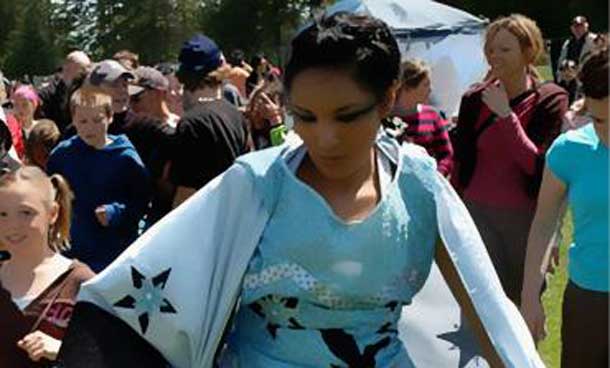
Shannen’s Dream Aboriginal Education – Hi-Ho Mistahey!
TORONTO – Special to NNL – Shannen Koostachin would look federal ministers in the eye and say, “That’s not good enough,” when they made promises to build a new school in her Cree community of Attawapiskat, by the shores of James Bay. She wasn’t even old enough to drive a car when she faced down the politicians.
Shannen was only 13 in 2008 when she led a movement for “safe and comfy” schools for First Nations children. Tragically, two years later, she died in a car accident May 31, 2010 while attending an off-reserve school.
What sparked her resolve was a remark in 2007 by a federal minister who said that construction of a new school in her community was just not a priority. Filled with a supernatural sense of self and pluck, she gathered her resolve to get that school built.
Hi-Ho Mistahey!
“You always have to fight [Aboriginal Affairs] if you want to get things done,” says Alanis Obomsawin, the acclaimed First Nations documentary filmmaker whose previous films include Kanehsatake: 270 Years of Resistance (1993), Richard Cardinal: Cry from the Diary of a Métis Child (1986), and Incident at Restigouche (1984).
Obomsawin brings Shannen’s story to life with the NFB documentary Hi-Ho Mistahey!, which premieres at this year’s Toronto International Film Festival.

Shannen turned to the children — an army of children — to take up the cause. The kids in the community had been getting sick (rashes, breathing problems, etc.) for years in their old school building. A diesel oil leak some 20 years earlier had contaminated the grounds. In 2000, they got a set of portables — cramped, freezing spaces. And since that year, minister after minister would pledge to build a new school.
“Everything surprised me when I got there,” said Obomsawin, who has made 40 films since 1971, is an officer of the Order of Canada, holder of a couple of Governor General’s awards, and was named to the Canadian Film and Television Hall of Fame in 2010.
“The mobiles are rundown and overcrowded. They were lacking so many things. It’s unjust. Those children have a right to a proper education.”
Education money siphoned off
As the film traces Shannen’s trajectory and life it also illuminates the dark reality of funding for aboriginal schools. The money — supposedly earmarked for education — held at Aboriginal Affairs and Northern Development, is often siphoned off for other matters (the film mentions the department having to pay lawyers or fund aid efforts to communities that have flooded or experienced some sort of natural disaster).
Funds provided for education in Attawapiskat amount to $8,000/pupil. Compare that to $15,000/pupil in Timmins, Ont.

Obomsawin says when she heard about Shannen’s death (the filmmaker had never met the teenager before), she decided to drop in on Attawapiskat, packing a tape recorder.
“The minute I entered the village, I could feel the sadness,” notes the director. “I felt discouraged but then… I decided to go to every classroom and meet the children. I fell in love with the children!”
At that moment, Obomsawin decided to return with a film crew. And over a period of three years, she made the documentary.
The documentary is a tribute to Shannen. Interviews with her family and friends paint an individual with enormous gifts of intelligence, compassion and courage. As her father Andrew repeats several times: “She was a special child.”
The snippets of footage with Shannen are riveting.
In one scene, with eloquence and quiet despair, she describes to an audience how it feels to have to go to school thousands of kilometres from home in order to get a better education. And with equal emotion, she’s out stumping on a podium or on Parliament hill shaming the politicians. It’s the kind of tenacity that gets results.
Just prior to her death, in 2009, the government came through with its promises and the new school is set to open in September 2014.
Shannen’s Dream Motion passed
After Shannen’s death, a group of students took up her cause and decided to keep pressing for better schools for all First Nations children. Their cause, Shannen’s Dream, went nationaland culminated in two major events: a presentation in Geneva to the United Nations about the issue and most crucially, the passing — unanimously by all MPs — of the Shannen’s Dream Motion in February 2012 recognizing the right of First Nations children to be educated in “safe and comfy” schools.
The ending builds to an emotional crescendo when Shannen’s father arrives in Ottawa in February 2012, making a speech after the passing of the motion in the same Parliamentary room where his daughter had spoken four years earlier.
Obomsawin screened the film for Shannen’s parents before its final cut.
“They cried a lot through it,” says the director, who admits to being very nervous about the screening, knowing how difficult it might be. “After it was done, they hugged me and said ‘it’s an honour for Shannen and we’re happy the film will be out there.'”
Shannen’s legacy lives in all those children in Attawapiskat and elsewhere. As her father stated: “A true leader doesn’t create followers. A true leader creates other leaders.”
Obomsawin says the victory belongs to the kids.
“Those children are like soldiers.”
Catch the documentary
Hi-Ho Mistahey! screens at the Toronto International Film Festival:
Sept. 7, 4:30 p.m. at the TIFF Bell Lightbox (Shannen’s parents, Obomsawin will be in attendance)
Sept. 9, 2 p.m. at Jackman Hall — Art Gallery of Ontario
Sept. 14, 6 p.m. at Jackman Hall
Plans are in the works for it to be broadcast on TV sometime in the future and livestreamed on the NFB website. For those in Toronto, the film will also run again at the Lightbox Nov 1 to 7.
By the way, the title Hi-Ho Mistahey! has its roots in Shannen’s family. Her parents would often say to their children, when they were toddlers, “I love you mistahey” (translates to “forever”) but the kids couldn’t pronounce “I love you” and instead, would respond, “Hi-ho mistahey!”
June Chua is a Toronto-based journalist who regularly writes about the arts for rabble.ca where this article originally ran. Re-Published on NNL with permission.
Photos courtesy of NFB.













